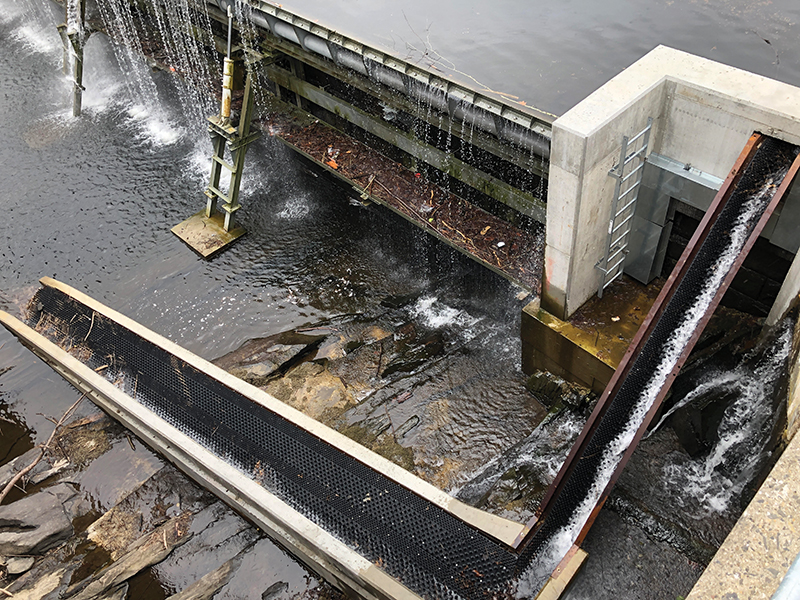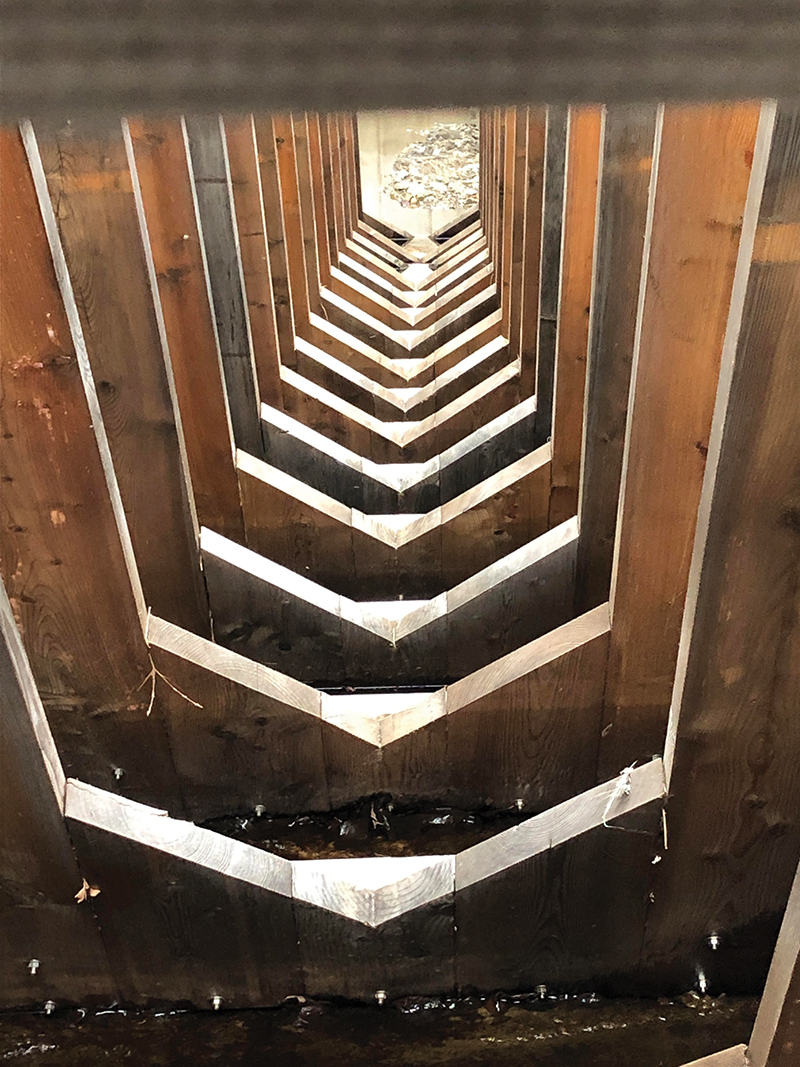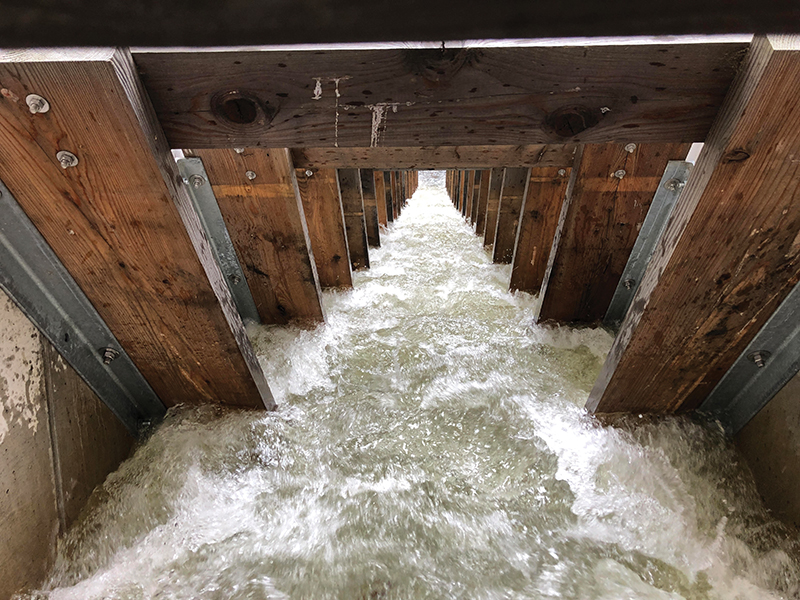
A Fishway for the
Tunxis (aka Farmington) River
Story and Photos by Steve Gephard and Sally Harold

The eel pass has angled plastic tiles with dowel-like projections equally spaced and the upper ramp has a partial overlay of plastic chain. Eels cannot surmount the dam and will find the entrance to the eel pass and wiggle up the shallow margins of the descending water to reach the top and pass into the pond.
Like a tree trunk dividing upward into branches and small twigs, our river systems have incredible complexity. The Connecticut River drains a vast, 11,000-acre watershed with many tributaries. Species of migratory fish ascended most of these, to differing degrees, depending upon which species and which tributary. The Connecticut River’s largest tributary, the 46-mile-long Farmington River—or the Tunxis, as the indigenous people called it—originates in the Berkshires of western Massachusetts, flows south into Connecticut, and then takes a sharp north turn before entering the Connecticut River.
The Tunxis historically hosted large runs of our native migratory fish, notably Atlantic Salmon, American Shad, Alewife, Blueback Herring, Sea Lamprey, American Eel, and two species of sturgeon, although the sturgeon probably did not penetrate much farther than 10 miles upstream due to heavy rapids. Beginning in the mid-1800s, these migratory fish were absent from all but the lowermost six miles due to the many, many dams of every size and description, built historically to power mills in the riverside towns. The Flood of 1955 breached many of those dams, but a sharp eye can still detect their overgrown remains, especially in Unionville and New Hartford. In the late 1960s, when the Connecticut River states began concerted efforts to restore migratory fish, attention in the Farmington River focused on the three intact dams and two partially breached dams in the lower half of the river.
The lowermost dam is the Rainbow Dam in Windsor, Connecticut. It has a fishway that was constructed in 1976 and enables migratory fish to pass the dam. Upstream of Rainbow, the partially breached Spoonville Dam was removed ten years ago, improving fish passage, and upstream of that, the partially breached Winchell-Smith Dam which allows some fish to pass is now slated for removal. That means that fish can now reach the two Collinsville dams, which were associated with the legendary Collins Company, maker of world-famous machetes, axes, and other tools. The first dam was built on a series of bedrock ledges in 1837 to provide hydro-mechanical power for Samuel Collin’s enterprise. Operations were later converted to generate hydroelectric power, and an additional powerhouse was constructed in 1935. The Lower Collinsville Dam was built about a mile downstream in 1914 to provide additional hydroelectric power. Both sites were so heavily damaged in the flood of 1955 that hydropower generation was abandoned, and in 1966 both dams were given to the State of Connecticut, now its Department of Energy and Environmental Protection (DEEP).
For decades, many parties aspired to restore hydroelectric power production at the two dams, and several feasibility studies were conducted. In 2018, following passage of federal legislation, involvement with the Town of Canton, and negotiations with the DEEP about a lease, Canton Hydro, LLC., was issued a license by the Federal Energy Regulatory Commission (FERC) to generate electricity at the upper dam. Construction to restore operations began shortly thereafter. The project, which reuses the 1935 brick powerhouse, has a generating capacity of 1 megawatt, estimated to be sufficient to power 485 Connecticut homes. For conservationists and migratory fish enthusiasts, the more exciting news is that soon, for the first time in nearly 200 years, fish passage will be established at this upper dam. When FERC issued its license, it required Canton Hydro to install effective fish passage at the dam.

Specially designed wooden “Denil” baffles are inserted at an angle every two feet into the sloped fishway. They slow down the velocity of the water and let fish swim up through the middle of the baffles.
A long, Denil-style fishway was constructed that will allow not only salmon, shad, and river herring to pass around the dam but also a variety of resident fish species, including trout. Any angler will tell you this river supports one of the best trout fisheries in New England! The fishway is a four-foot wide, recessed, concrete trough built at a 9% slope. Every two feet, a specially-designed wooden baffle is installed at a 45-degree angle to slow the rush of descending water. These baffles create a turbulence that makes it possible for many species of fish to swim up the fishway. Four resting pools are set between the sloped fishway sections allowing fish to rest periodically as they make the nearly 19-foot elevation gain to reach the head-pond and habitat beyond. A belowground viewing room with a window into the fishway offers an opportunity for video monitoring and allows biologists to evaluate the fishway’s performance and keep track of increases in fish populations over the years. The entrance of the Denil fishway is downstream of the powerhouse, adjacent to where the water rushes out from the turbine. The forceful flow of water coming from under the powerhouse will deter fish from entering or exploring that area. Instead, they will sense the attraction flow issuing from the fishway and swim against that current to get upstream.
 Juvenile American Eels are not adept at using Denil fishways, and for them, Canton Hydro has built a specially designed eel pass located at the north end of the spillway. The eel pass is a wetted, steeply sloped trough with a roughened floor of short knobs and plastic chain that an eel can climb. It requires only a fraction of the flow required by the Denil.
Juvenile American Eels are not adept at using Denil fishways, and for them, Canton Hydro has built a specially designed eel pass located at the north end of the spillway. The eel pass is a wetted, steeply sloped trough with a roughened floor of short knobs and plastic chain that an eel can climb. It requires only a fraction of the flow required by the Denil.
Migratory fish move downstream, too. Both post-spawned adults and juveniles heading to sea are vulnerable to death and injury if they pass through a turbine. Canton Hydro has installed features to prevent that. First, the turbine intake is covered with a screen that has ¾-inch gaps between the bars, enough to block most fish from passing, including the adult American Eel that needs to migrate downstream to the sea to spawn. Additionally, the screen is angled across the power canal, so fish are diverted from right to left, away from the intakes and directed to a large surface gate that spills water from the top of the dam to the river below, safely depositing fish into a deep plunge pool. For the migrating eel that prefer to stay near the bottom, there is another option. A large-diameter pipe with four-inch openings spaced every ten feet is anchored to the bottom of the canal at the base of the intake screen. The pipe bends upwards, comes out of the water and extends over the dam. A special vacuum pump draws water through the pipe so that when an eel, searching for a way around that barrier screen, finds a hole and is sucked into the pipe, it will be transported through the pipe, up and over the dam and then deposited in that same plunge pool downstream. This “Zig Zag” style downstream eel pass is commonly used in Europe but its installation in Collinsville is believed to be the first such application in North America.
Canton Hydro hired Wasserkraft of Austria to design the hydro plant and fish passage facilities and Hemlock Construction from Torrington, Connecticut, to do most of the construction. The project began generating electricity on an interim basis in late 2021. Operation was suspended during the severe summer drought of 2022 but resumed that fall. The fishways did not begin full operation until April of 2023. Much of the facility can be viewed from the Rt. 179 bridge in Collinsville, but generally the public will not be permitted inside the gates for a close-up view. Occasional tours and open houses are anticipated, and a grand opening was held in May 2022.
So, what about that Lower Collinsville Dam? Canton Hydro declined to pursue licensing of the Lower Collinsville Dam, agreeing with many previous studies that it is not economically feasible to generate power at that site. The dam’s owner—the CT DEEP—is planning on totally removing the dam. That project is in the design stage now. Once the dam is gone in another year or three, migratory fish like American Shad and Sea Lamprey will be free to run up the Tunxis, through the Upper Collinsville Fishway, to reach another 25-plus miles of free-flowing habitat. In the meantime, the Upper Collinsville Fishway will be passing those valuable Farmington River trout along with other native species.
Steve Gephard is a fisheries biologist. He recently retired after 40 years with the Connecticut Department of Energy and Environmental Protection (DEEP) Fisheries Division. He continues to work in the field as an independent consultant.
Sally Harold is an independent consultant for various fish passage and habitat restoration projects. Previously she worked as a fish restoration project manager for The Nature Conservancy.

